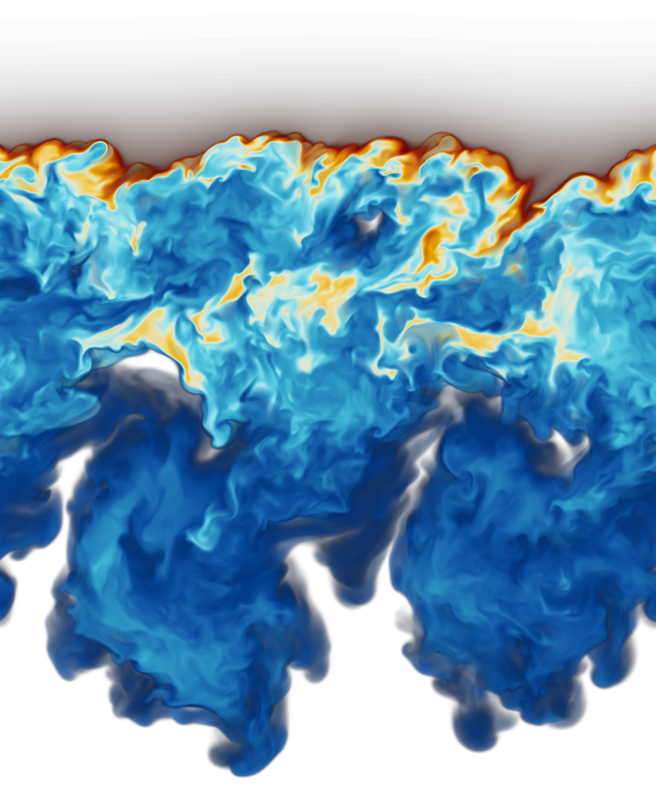About Xcompact3dXcompact3d is a Fortran-based framework of high-order finite-difference flow solvers dedicated to the study of turbulent flows. Dedicated to Direct and Large Eddy Simulations (DNS/LES) for which the largest turbulent scales are simulated, it can combine the versatility of industrial codes with the accuracy of spectral codes. Its user-friendliness, simplicity, versatility, accuracy, scalability, portability and efficiency makes it an attractive tool for the Computational Fluid Dynamics community.
XCompact3d is currently able to solve the incompressible and low-Mach number variable density Navier-Stokes equations using sixth-order compact finite-difference schemes with a spectral-like accuracy on a monobloc Cartesian mesh. It was initially designed in France in the mid-90's for serial processors and later converted to HPC systems. It can now be used efficiently on hundreds of thousands CPU cores to investigate turbulence and heat transfer problems thanks to the open-source library 2DECOMP&FFT (a Fortran-based 2D pencil decomposition framework to support building large-scale parallel applications on distributed memory systems using MPI; the library has a Fast Fourier Transform module). When dealing with incompressible flows, the fractional step method used to advance the simulation in time requires to solve a Poisson equation. This equation is fully solved in spectral space via the use of relevant 3D Fast Fourier transforms (FFTs), allowing the use of any kind of boundary conditions for the velocity field. Using the concept of the modified wavenumber (to allow for operations in the spectral space to have the same accuracy as if they were performed in the physical space), the divergence free condition is ensured up to machine accuracy. The pressure field is staggered from the velocity field by half a mesh to avoid spurious oscillations created by the implicit finite-difference schemes. The modelling of a fixed or moving solid body inside the computational domain is performed with a customised Immersed Boundary Method. It is based on a direct forcing term in the Navier-Stokes equations to ensure a no-slip boundary condition at the wall of the solid body while imposing non-zero velocities inside the solid body to avoid discontinuities on the velocity field. This customised IBM, fully compatible with the 2D domain decomposition and with a possible mesh refinement at the wall, is based on a 1D expansion of the velocity field from fluid regions into solid regions using Lagrange polynomials or spline reconstructions. In order to reach high velocities in a context of LES, it is possible to customise the coefficients of the second derivative schemes (used for the viscous term) to add extra numerical dissipation in the simulation as a substitute of the missing dissipation from the small turbulent scales that are not resolved. Xcompact3d is currently being used by many research groups worldwide to study gravity currents, wall-bounded turbulence, wake and jet flows, wind farms and active flow control solutions to mitigate turbulence. |
Acknowledgements
Sylvain Laizet and Eric Lamballais would like to thank Imperial College London and The University of Poitiers for agreeing to make the framework Xcompact3d available for the scientific community.
In no particular order, Kay Schäfer, Paul Bartholomew, Ricardo Frantz, Cedric Flageul, Georgios Deskos, Felipe Schuch, Stefano Rolfo, Jian Fang, Christos Vassilicos, Sylvain Lardeau, Ning Li, Charles Moulinec, Nikos Bempedelis, Thibault Lestang, Semih Akkurt, Véronique Fortuné, Jorge Silvestrini and Thibault Dairay are acknowledged for helping in the development of Xcompact3d.
Sylvain Laizet and Eric Lamballais would like to thank Imperial College London and The University of Poitiers for agreeing to make the framework Xcompact3d available for the scientific community.
In no particular order, Kay Schäfer, Paul Bartholomew, Ricardo Frantz, Cedric Flageul, Georgios Deskos, Felipe Schuch, Stefano Rolfo, Jian Fang, Christos Vassilicos, Sylvain Lardeau, Ning Li, Charles Moulinec, Nikos Bempedelis, Thibault Lestang, Semih Akkurt, Véronique Fortuné, Jorge Silvestrini and Thibault Dairay are acknowledged for helping in the development of Xcompact3d.
About the framework |
Bartholomew P., Deskos G., Frantz R.A.S., Schuch F.N., Lamballais E. & Laizet S, 2020, Xcompact3D: An open-source framework for solving turbulence problems on a Cartesian mesh, SoftwareX, 12, 100550
|
About the numerical methods |
Laizet S. & Lamballais E., High-order compact schemes for incompressible flows: a simple and efficient method with the quasi-spectral accuracy, J. Comp. Phys., vol 228-15, pp 5989-6015, 2009
Lamballais E., Fortune V. & Laizet S., Straightforward high-order numerical dissipation via the viscous term for Direct and Large Eddy Simulation, J. Comp. Phys., Vol 230-9, pp 3270-3275, 2011 Gautier R., Laizet S. & Lamballais E., A DNS study of jet control with microjets using an alternating direction forcing strategy, Int. J. of Computational Fluid Dynamics, 28, pp 393-410, 2014 Mahfoze, O. A., & Laizet, S., Non-explicit Large Eddy Simulations of turbulent channel flows from Reτ= 180 up to Reτ= 5,200, Computers & Fluids, 105019 |
About the parallel strategy |
Laizet S. & Li N., Incompact3d, a powerful tool to tackle turbulence problems with up to 0(10^5) computational cores, Int. J. of Numerical Methods in Fluids, Vol 67-11, pp 1735-1757, 2011
Li N. & Laizet S., 2DECOMP&FFT - a highly scalable 2D decomposi on library and FFT interface, Cray User Group meeting: Simulation comes of age, Edinburgh, Scotland -- 24/05-27/05, 2010 Laizet S., Lamballais E. & Vassilicos J.C., A numerical strategy to combine high-order schemes, complex geometry and parallel computing for high resolution DNS of fractal generated turbulence, Computers & Fluids, vol 39-3, pp 471-484, 2010 Xcompact3d is using the open-source library 2D Decomp&FFT, available at github.com/xcompact3d/2decomp-fft |

